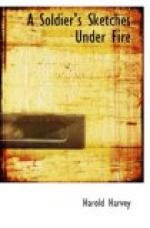After an attack there was generally a roll call—from which there were many absentees.
More trying—more wearing and tearing to the nerves—than anything that in my experience ever followed it was the stand to itself. The moments, minutes, even hours, that followed that old familiar order, “stand to,” were the worst I ever went through. As every eventide comes on I still feel just a little—just a very little—of what I felt then. Even now: and I fear me I always shall till death bids me stand to.
I see I have written so much with only one illustration, that perhaps it won’t be amiss if I place here a few typical heads and a couple of typical full figures, the original sketches of which I pencilled in spare places in my notebook at odd times. If they be really typical they need no labelling.
[Illustration: Typical figures and figure-heads.]
CHAPTER V.
The lighter side of trench life.
That there was (and is) a lighter side, a social side, of trench life, as of the life generally of a soldier on active service, even in this war, merely incidental remarks of mine such as could not be omitted from any true and fair description of that life must furnish abundant evidence; but this lighter side was, in my experience, so very real and so pronounced that to illustrate a few set observations thereon I take a few sketches from my notebook out of the order in which I find them in it.
SING-SONGS.
Our concert parties were “immense,” and there was no forced gaiety in our enjoyment of them. Some of the best sing-songs were in “Leicester Lounge,” named after the luxurious resort (which it didn’t resemble) hard by the Empire Theatre. The reflection occurs to me for the first time that only men with whom high spirits were rampant would or could have been so fond of inventing such nicknames as—in mood jovially ironic—we coined for all sorts of places, persons and things. “Leicester Lounge” was a dug-out adjacent to “Hammersmith Bridge,” and the surroundings of “Hammersmith Bridge,” there being nothing in connection with them to suggest—save by absence—either a garden or a city, were “the Garden City.”




